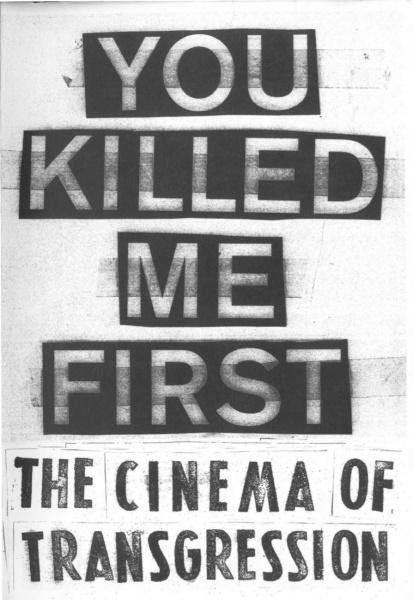Karin Grace Oen: Admonition and the Academy: Installation, Video, and Performance Art in Reform Era China (2012)
Filed under thesis | Tags: · 1980s, 1990s, art, art history, china, installation art, performance art, video, video art

Wu Shanzhuan, The Big Characters, 1985. (source)
“China’s Reform Era (1978-present) has seen the reinvigoration of academic, and artistic practice, and a rapprochement between the Chinese Communist Party and the intellectual elite. At its beginnings in the early- to mid-1980s the new availability of foreign texts and media led to Culture Fever, a widespread phenomenon throughout the intellectual and artistic spheres characterized by enthusiasm for the philosophy, literature, and art of the West and pre-Communist China and the simultaneous uptake of discrete Western and Confucian philosophies. These discussions often addressed modernity and modernism in China, a crucial homology to early twentieth century Chinese negotiations in literature and the arts and the development of an amalgamated ‘Chinese modernism’ comprised of elements of both Confucian and Western philosophy and aesthetics.
As this dissertation argues, key early experimental works of the Reform Era by Zhang Peili, Wu Shanzhuan, and Zhang Huan reveal a proclivity for subtle and indirect admonitory messages about China’s socio-political climate – a contemporary inhabitation of the traditional elite scholar-artist and his obligation to criticize immoral or unjust policies or actions. This admonitory practice was built by artists educated in elite academies (specifically, the Central Academy of Fine Art in Beijing and the Zhejiang Academy of Fine Art in Hangzhou) yet utilized completely new and non-academic media. What this thesis terms as an ‘art of admonition’ utilized traditional tropes, including direct remonstrations of officials, withdrawal from official life in protest, and the concept of the ‘middle hermit’ – a scholar who admonishes official policy subtly and indirectly.
The experimental practices of artists after their graduation from elite academies stemmed from the extra-curricular resources made available to them, especially the schools’ libraries. The connection of these unofficial works to the official academies, their validation by art market success, and the subsequent official endorsement accorded to these and other artists in the later Reform Era blurs the distinctions between official and unofficial artistic practice in China, suggesting a strong endorsement of the dissident artist’s role as ‘middle hermit’.” (Abstract)
Thesis, Ph. D. in History, Theory, and Criticism of Art and Architecture
Dept. of Architecture, Massachusetts Institute of Technology, 2012
Supervisor: Caroline A. Jones
214 pages
PDF, PDF (13 MB, updated on 2017-1-11)
Comment (0)You Killed Me First: The Cinema of Transgression (2012) [English/German]
Filed under catalogue | Tags: · 1980s, art, cinema, experimental film, film, horror, humour, sex, violence

“Basically, in one sentence, give us the definition of the ‘Cinema of Transgression’.” Nick Zedd: “Fuck you.”
Nightmarish scenarios of violence, dramatic states of mind, and perverse sexual abysses – the films of the Cinema of Transgression that were consciously aimed at shock, provocation, and confrontation, bear witness to an extraordinary radicality. In the 1980s a group of filmmakers from the Lower East Side in New York went on a collision course with the conventions of American society. Transcending all moral or aesthetic boundaries, the low budget films reveal social hardship met with sociopolitical indifference. Sometimes shot with stolen camera equipment, the films contain strident analyses of life in the Lower East Side defined by criminality, brutality, drugs, AIDS, sex, and excess. The catalogue is published on the occasion of the worldwide first exhibition on the Cinema of Transgression, You Killed Me First at KW Institute of Contemporary Art in Berlin.
The catalogue includes contributions by Sylvère Lotringer, Carlo McCormick, Jonas Mekas, Susanne Pfeffer, Jack Sargeant, Nick Zedd and collages by Leonard Neumann LSD.
Edited by Susanne Pfeffer
Publisher KW Institute of Contemporary Art, Berlin, and Walther Koenig, Cologne, 2012
ISBN 3863351576
176 pages
Video from exhibition (3 min)
PDF (110 MB, no OCR, updated on 2016-12-23)
Comment (0)David Crowley, Daniel Muzyczuk (eds.): Sounding the Body Electric: Experiments in Art and Music in Eastern Europe 1957–1984 (2012) [English/Polish]
Filed under book | Tags: · 1950s, 1960s, 1970s, 1980s, art, art history, avant-garde, central europe, east-central europe, eastern europe, electroacoustic music, experimental film, happening, sound, sound art, synaesthesia, video art, visual music

“In the aftermath of Stalinism, composers and artists in Eastern Europe were given new opportunities to experiment. New recording studios equipped with magnetic tape recorders and later, synthesizers were established, first in Warsaw in 1957 and then throughout Eastern Europe. New and often challenging forms of music were produced in these laboratories of sound.
The connections between the visual arts and experimental music were closer in the 1960s than perhaps any time before or since. Sound and image combined in artists’ films, ‘happenings’ and sounding installations. Experimental forms of notation were also created to stimulate uninhibited musical expression.
The early happenings and actions of the 1960s were associated with intellectual freedom and reform. The exhilaration of experimentation declined during the decade and in the 1970s new critical forms of art emerged which associated sound with surveillance and censorship.
This book accompanying an 2012 exhibition at the Muzeum Sztuki in Łódź explores both the optimism and the anxiety that was to be found in the experimental zone of art and music.”
The exhibition later moved to the Calvert 22 Gallery in London.
Artists: Collective Actions, Walerian Borowczyk, Andrzej Dłużniewski, Szábolcs Esztényi, László Vidovszky, Krzysztof Wodiczko, Grzegorz Kowalski, Zygmunt Krauze, Henryk Morel and Cezary Szubartowski, Eugeniusz Rudnik, Bulat Galeyev, Milan Grygar, Milan Knížák, Oskar Hansen, Zofia Hansen, Zoltán Jeney, Vitaly Komar & Alexander Melamid, Katalin Ladik, Jan Lenica, Dóra Maurer, Vladan Radovanović, Józef Robakowski, Bogusław Schaeffer.
Dźwięki elektrycznego ciała: Eksperymenty w sztuce i muzyce w Europie Wschodniej 1957–1984
Publisher Muzeum Sztuki, Łódź, 2012
ISBN 9788387937980
222 pages
David Crowley’s presentation at MoMA (video, 50 min)
Sounding the Body Electric: A Conversation (Michał Libera, Art Margins)
Accompanying audio 2-CD
PDF
PDF (exh. guide, Calvert 22 Gallery, London, 2013, added on 2023-12-27)

